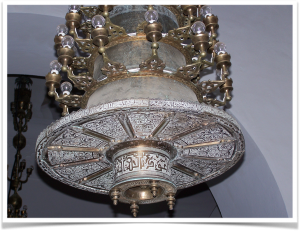


Ali Alibhai is currently working on his book project, entitled, Sacred Sound and Symbolism in Medieval Islamic Society: The Bell-lamp and the Adhān
Dr. Ali Alibhai, Visiting Assistant Professor at the O’Donnell Institute, is currently working on his book project, entitled, Sacred Sound and Symbolism in Medieval Islamic Society: The Bell-lamp and the Adhān. Analyzing sound from the perspectives of Muslims and Christians, this book is the first comparative study of its kind on the subject of the public expression of different aural and visual forms of sacred sound in medieval Islamicate societies. For Muslims, this sacred sound was the adhān, an oral rite consisting of vocalized formulas recited by a muezzin to signal the prescribed times for communal prayer. For medieval Christians living in the Near East and eastern Mediterranean basin, the beating of semantra (wooden boards), and in the west, the ringing of bells were common rituals that called the faithful to gather.
As cultural and geopolitical circumstances changed in different eras and regions of the Islamic world, so did the nature of Muslim and Christian interaction and coexistence. As a result, meanings and symbolism attached to sacred sound in these societies also evolved, changing both soundscapes and visual cultures in medieval Islamic society. Sacred Sound and Symbolism is a historical analysis and comparative study of the evolving meanings of the adhān and the bell in medieval Islamic civilization through interdisciplinary research derived from historical, material cultural, art historical, and religious documentation and sources. It is also the first monograph to closely study the persistent medieval Maghribi Muslim tradition of forging metal mosque lamps made from appropriated Christian bells between the tenth and fourteenth century.

Minecraft architecture of the medieval ruins of the Umayyad palace city of Madinat al-Zahra
This past fall, Alibhai taught a new class at UTD on the art of medieval Islamic Spain. The class surveyed the history, art history, and material culture of ancient and medieval Spain spanning across several centuries. Students explored several aspects of Roman, Visigothic, and Islamic Spain. Specific focus was given to how Islamic culture flourished in the medieval Iberian peninsula between 711 and 1492 and how it left a lasting impact on the history of Spain and its visual and material culture. Themes of art history, numismatics, social history, architecture, engineering, agriculture, geography, and political history were also discussed. Many students who took this class produced creative projects to accompany their final research. These projects ranged from comic books, animations, Minecraft recreation of medieval monuments, and digital 3d modeling.
Ali Alibhai holds a PhD from the Near Eastern Languages and Civilizations department at Harvard University (November 2018). He is a scholar of the histories and cultures of Muslim societies and focuses his research on the medieval Maghrib and Mediterranean worlds, with specializations in the histories and art and architecture of medieval Tunisia, Sicily, Spain, and Morocco. Ali’s academic work combines the study of textual and historical studies with art and architectural history to further understand the socio-cultural history and material culture of the medieval Islamic world. He is currently a Visiting Assistant Professor in Art History at the University of Texas at Dallas and the Edith O’Donnell Institute of Art History.